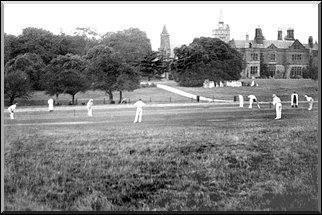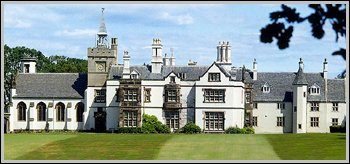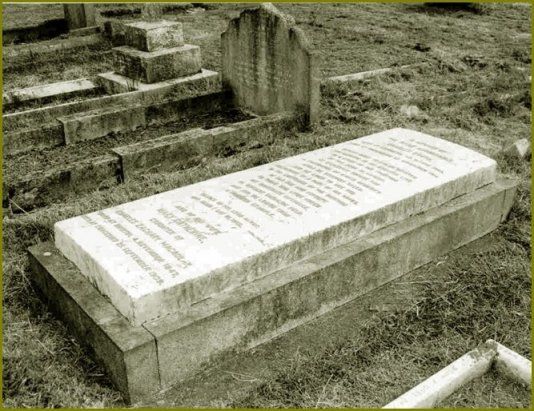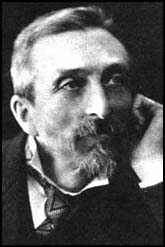Charles Booth (1840 - 1916)
 |
The village of Thringstone has a special claim to fame in its association
with the Rt Hon Charles Booth PC (1840 - 1916) of Gracedieu Manor, the great
philanthropist and pioneer of social research, whose tomb and beautiful epitaph
can be found on the north side of Saint Andrews
churchyard.
Mr Booth was a shipping line owner whose revolutionary inquiry into the
conditions of the London working class and tireless campaign for the
introduction of old age pensions helped lay the foundations of the modern
welfare state.
He was born at Liverpool on 30 March 1840, the third son of Charles Booth and
Emily Fletcher. Charles Booth Snr was a wealthy corn merchant who, in 1860,
left to each of his five children the sum of £20,000. In 1862, the young
Charles combined his fortune with that of his eldest brother Alfred, investing
it in the construction of two steamships, the Augustine and the
Jerome, with the aim of building up a fleet to carry merchandise to and
fro across the Atlantic. From this relatively modest enterprise grew the Booth
Steamship Company, a huge concern which gained interests in many parts of the
world, especially in the Amazon River trade of South America, and of which
Charles was Chairman until 1912. The construction of the great harbour of
Manaus in Brazil occurred as a result of the Booth enterprise.
In 1871, Charles married Mary Macaulay of London, one of the distinguished
Macaulay family, whose grandfather, Zachary, had been instrumental in bringing
about the abolition of slavery and whose uncle was the great historian, Lord
Thomas Babbington Macaulay.
With a station in life so far removed from the perspectives of the working
poor, one might wonder just how it was that Booth came to divert so much of his
energy and resources into the arena of social questions and, moreover, how this
giant figure came to be buried within the humble confines of Thringstone
churchyard.
Charles Booth always seems to have had an inherent concern for the welfare of
working men and as a young man he became a Radical and campaigned for the
Liberal Party in Liverpool. But he quickly became disillusioned by the fray of
local politics and found that his efforts to bring about change through these
channels were of little effect. Thereafter, Booth was never a keen partisan to
any political ideology and remained independent in his actions. However, it was
while campaigning for the Radical cause in the General Election of 1865 that
Charles made house to house visits in the Toxteth slums. Here he encountered
ignorance, poverty and squalor on a scale he had never before imagined and
which deeply shocked him.
Like many other better off Victorians, Charles had hitherto been unaware of the
terrible living conditions suffered by so many of the working class. An early
writer on the subject of poverty, Henry Mayhew, once described the poor as 'a
large body of persons of whom the public has less knowledge than the most
distant tribes of the earth'. More affluent citizens were able to ignore
poverty close to home because of the segregated 'zoning' of many British
cities, a physical distance between the poor and the better off
There were those who were anxious to play down the problem of pauperism,
fearing that an acknowledgment of such would fan the flame of revolution and
overturn the social order. Many blamed the poor themselves for their misfortune
and saw poverty as a consequence of their own fecklessness and personal
inadequacies. In any case, very little had ever been written about poverty and
with so many contradictory views being aired about the nature and extent of
poverty in England at that time, Booth sought to discover an accurate picture
of existence among the working masses of London, using statistical methods of
study.
In 1886, he launched his monumental inquiry, a survey to which he was dedicated
without intermission for the next seventeen years. The results of his
investigations were published in seventeen volumes between 1889 and 1903,
entitled "Life and Labour of the People in London".
The years of painstaking work necessary to compile this survey involved not
only Booth, but also a large body of assistants, including his wife's cousin,
Beatrice Potter (later Mrs Sydney Webb) and Mary Booth revised and corrected
it. Booth's granddaughter, Belinda Norman-Butler, estimated that the inquiry
must have incurred a personal expense to Charles well in excess of
£40,000. Called by 'The Times' the grimmest book of its generation, the
survey revealed that approximately one third of London families lived in abject
poverty, on about £1 per week or less, and a successive inquiry by Seebohm
Rowntree in York produced similar conclusions.
The efforts of Booth and Rowntree provided irrefutable evidence of the enormity
and wretchedness of poverty in England and were sufficient to end argument on
the subject. Booth believed that if given help people would improve themselves
and recommended major state intervention to this end. He saw the need for
better wages and educational opportunity as a fundamental urgency and
campaigned vigorously for the introduction of old age pensions. One of his
papers, 'Pauperism: A Picture. Endowment of Old Age: An Argument' (1891), was
based in part on studies carried out into the conditions of the poor in Ashby
de la Zouch. Charles remained undeterred in his campaign for state pensions,
despite frequent attacks of ridicule from many of his peers. One described his
proposition to be 'so Utopian that it did not provide food for serious
discussion'.
In 1904, Booth was appointed a member of the Privy Council by the Prime
Minister, Arthur Balfour, and his influence was instrumental in the passing of
the Old Age Pensions of 1908, though Booth criticised this Act for granting
pensions not to all, but only to those whose incomes fell below a certain
level. In February 1910, the Labour Party, then in its infancy, presented Booth
with an illuminated address in the House of Commons, 'To you more than any
other man' they wrote, 'this first instalment of justice to the aged is due'.
Other recognition of his work came from the Universities of Oxford, Cambridge
and Liverpool, which awarded him honorary degrees, and at Liverpool a
professorship of Social Science was subsequently established in his name.
 |
The arrival of Charles and Mary Booth at Gracedieu occurred quite by chance.
The family had been living with Mary's father in London and were anxious to
find a suitable country residence, located somewhere between London and
Liverpool, where Booth's main interests lay
In the spring of 1886, Charles took his two eldest children on a short vacation
to the Midlands with the object of visiting some of the areas cathedrals and
also looking out for a potential family residence. The trip included a casual
visit to Gracedieu Manor, which was then in a rather deplorable condition, but
Charles and his children were instantly captivated by its woodland setting.
'The ground is picturesquely broken', wrote Mary Booth in 1918, 'divided into
hill and dale, covert and open space, and traversed by a winding rushing brook,
so that it affords a great variety of beauty'
Charles made an instant decision to take on the lease of the manor from the De
Lisle family, leaving to his wife the considerable task of making the place
habitable. This was to be his home until his death some thirty years later, and
up until shortly before he died his daily routine almost always included a
ramble through Gracedieu Wood
 |
During the earlier years, Charles's relentless commitments to the inquiry and
to his business interests meant that he was frequently absent from Gracedieu,
sometimes for long periods, but when increased leisure time became available to
him, he became an active participant in the life of the district. The Coalville
historian, 'Lavengro', wrote, "he made the manor a focal point for the
social life of the district and became - in fact, if not in name - the Squire
of Thringstone". The village was to benefit immensely in its development
and welfare as a result of Charles and Mary Booth's constant acts of kindness
and generosity.
Examples of their charity seem too many to enumerate here, and doubtless the
Booths would have made untold other acts of personal kindness in complete
anonymity. Of their deeds, the founding of present day Community Centre
is best known, and it is hoped to put together a detailed history of the centre
in the near future. Other examples of the Booths' charity seem to have been
forgotten with the passage of time, though I would like to mention several here
on account of their particular interest.
In 1898, Charles was instrumental in the founding of the Whitwick and
Thringstone District Nursing Association, apparently in response to an outbreak
of typhoid fever in Cademan Street, Whitwick. No doubt the Whitwick Colliery
Disaster of the same year had also served as an influential factor. Mr Booth
contributed £50 annually to this organisation (of which he was president),
in addition to other donations made by Mrs Booth for special purposes, though
at the Annual General Meeting held in June 1902, the committee moved that Mr
Booth's subscription should be reduced to £10 per annum in order to
encourage the association to become self-supporting. The Coalville Times of
13th June 1902 reported that "Mr Booth considered that the request was
unique in the history of the world!".
In March 1908, it was reported that through the generosity of Mr and Mrs Booth,
a Lady District Visitor had been appointed and had taken up residence in the
vicinity. According to the late Mr Frederick Sykes (1907 - 76) of Thringstone,
who was once under groom and chauffeur at the manor, the Booths had also
provided Dr J C Burkitt of Whitwick with a motor car. Mr Sykes explained
(tongue firmly in cheek) that the car had been given because Mrs Booth's family
were "always having babies", the doctor having sped previously to the
manor on horseback!
In January 1907, Mr Charles Booth Jnr, in the absence of his father, officially
opened the Whitwick and District Gymnasium and School of Arms. This was built
by Mr Booth on Silver Street, 'to provide physical exercises combined with
drill and rifle practice for boys and young men. Mr Booth also bore the expense
of a caretaker and instructor, one Sergeant Major Turnbull RE, and in November
1909 he also provided a shooting range in an adjacent field. Members could buy
seven rounds of ammunition for a penny. The gymnasium, which later doubled up
as the Arcadia Dance Hall, was sold into private hands after the First World
War and is now divided into three private houses (numbers 6a to 6c Silver
Street).
In 1914, Mary Booth built 'The Meadows' on Loughborough Road, Thringstone.
Originally known as 'Saint Andrews' Home', this was a large white house used as
a convalescent home for women and girls from London, and run from Mrs Booth's
private income. This later became the home of Charles Booth Jnr and then a
country retreat for Lt Col Tom Booth, the eldest son, before eventually being
sold off by the family. Regrettably, as with so many local buildings of
historic and aesthetic value, this was demolished in 1989, having fallen into a
state of disrepair. It is perhaps at least some measure of consolation that a
large modern nursing home has since been built on this site and which retains
the title, "The Meadows"
Another, more enduring instigation was the founding of Gracedieu Park Cricket
Club by Charles in 1887. For many years, matches were played in the manor
grounds and Lavengro records that these were sometimes followed by 'sumptuous
feeds at the manor', which were remembered for years afterwards by local
people. The Cricket Club is now based in a field to the rear of the Bulls Head.
Sadly, Mrs Booth's one last wish of kindness to the people of the district was
denied. In January 1938 (a year before her death) she wrote to her daughter,
Meg, "Mr de Lisle has absolutely turned down my request to buy the wood
( for the benefit of the people of Leicestershire). I am very, very
disappointed". It is remembered that the Booths established primrose and
rhododendron valleys in the wood, which were tended every day by two elderly
gentlemen from Golden Row, Whitwick.
Charles Booth passed away on Thursday, 23rd November 1916 at Gracedieu aged
seventy-six years. In a lengthy obituary, the Coalville Times recorded: 'The
body, enclosed in a plain oak coffin, was removed from Gracedieu Manor on
Sunday morning and placed in the church on the chancel steps under a small
guard of the Whitwick and Thringstone Volunteer Training Corps'. Here, the body
rested for several hours prior to the service, while outside an enormous and
magnificent collection of floral tributes mounted to form 'a bank of bloom'
near the simple ivy-lined earth grave.
In her memoirs, Mary Booth wrote , Charles '...was buried in the churchyard of
the little church at Thringstone that he was accustomed to attend, and where
two of his daughters were married. Those of his relatives and friends who were
able to come quite filled the small building, and there was but little room
left for the villagers who loved him. But they assembled in the churchyard,
where altogether sang the hymn, "O God, our help" at the grave side'.

In 1920, a tablet designed by Sir Charles Nicholson was unveiled to Mr Booth's
memory in the crypt of Saint Paul's Cathedral, London. The
Reverend C Shrewsbury , Vicar of Thringstone,
accompanied members of the Booth family at the unveiling ceremony, which was
performed by Sir Austen Chamberlain, then Chancellor of the Exchequer. Booth
was a great admirer of Saint Pauls and had presented the Cathedral with a copy
of Holman Hunt's most famous painting, "The Light of the World" in
1904. The painting cost Booth £1,000, and an additional £5,000 to
send it on a world tour. Lady Holman Hunt was among the mourners at Thringstone
Church on the occasion of Charles Booth's funeral.
Mary survived her husband by more than twenty years and died on 25th September
1939 aged ninety two years. It is said that news of the outbreak of war was
kept from her. She was laid to rest with her husband and their simple, flat
white marble tombstone reads:
THE RIGHT HONOURABLE
CHARLES BOOTH,
BORN AT LIVERPOOL 30 MARCH 1840,
DIED AT GRACEDIEU 23 NOVEMBER 1916.
DURING MANY YEARS, HE DEVOTED
THE LEISURE OF AN ARDUOUS LIFE
TO A STUDY OF THE CONDITION
OF THE POOR IN LONDON.
HE DILIGENTLY SOUGHT FOR
A FOUNDATION ON WHICH REMEDIES
COULD BE SECURELY BASED:
AND HE LIVED TO SEE THE
FULFILMENT OF A PART OF HIS HOPES,
IN THE LIGHTENING OF THE BURTHEN
OF OLD AGE AND POVERTY.
TO THOSE WHO LIVED UNDER
HIS IMMEDIATE INFLUENCE,
HE BROUGHT UNFAILING HELP
AND JOY : HE LEAVES THEM
A PRECIOUS EXAMPLE.
REJOICE IN THE LORD ALWAY:
AND AGAIN I SAY REJOICE. PHIL IV.4.
AND OF HIS WIFE
MARY CATHERINE
DAUGHTER OF
CHARLES ZACHARY MACAULAY,
BORN AT BRISTOL 4 NOVEMBER 1847,
DIED AT GRACEDIEU 25 SEPTEMBER 1939.
TRANSCRIPT OF CHARLES BOOTH'S MEMORIAL TABLET IN SAINT PAUL'S CATHEDRAL, LONDON
CHARLES BOOTH
MERCHANT SHIPOWNER
MEMBER OF HIS MAJESTY'S MOST
HONOURABLE PRIVY COUNCIL
BORN 1840 DIED 1916
Throughout his life having at heart
the welfare of his fellow citizens and
believing that exact knowledge of
realities is the foundation of all reform,
he devoted himself to the examination
and statement of the social, industrial
and religious condition of the people
of London. Those who knew him loved
him and drew inspiration from the
energy of his leadership and the
originality of his mind.
IN FAITH HOPE AND LOVE
THEY DEDICATE THIS TABLET TO HIS MEMORY.
EXPECTANS RESURRECTIONEM
MORTUORUM.
 |
Click here for detailed photographs of Charles Booth's tomb
Above information taken from, "Saint Andrews, Thringstone: Its Fabric,
Its Ministers and Their Flock", by Stephen Neale Badcock, unpublished,
1997.
Quotes about Charles Booth...

In her diary, Beatrice Potter recorded her first impressions of Charles
Booth (9th February 1882):
It is difficult to discover the presence of any vice or even weakness in
him. Conscience, reason and dutiful affection are his greatest qualities; what
other characteristics he has are not to be observed by the ordinary friend. But
he interests me as a man who has his nature completely under his control, and
who has risen out of it, uncynical, vigorous and energetic in mind without
egotism.
Bernard Newman (1897 - 1968), British Author and Lecturer
wrote:
I remember how, as a boy, my father took me over to Gracedieu Manor to
see Charles Booth - my father was a keen Liberal. On the way he told me about
the man we were going to see. Charles Booth did not make political speeches,
but he investigated social problems scientifically - especially the conditions
under which the poor lived. We sat in his study, and he spoke soberly of his
investigations. But then a great passion took control of him as he described
what had to be done. He began to talk about Old Age Pensions - of which I had
then never heard. So great was his enthusiasm that he persuaded the politicians
to take up his idea- the beginning of the Welfare State: a modest beginning-
5s.a week.
Booth was not of Leicestershire origin, but at the time it was a Radical
county, and he settled there because he found the atmosphere congenial and
support for his ideas. I was too young to understand all he said, but the force
of his personality affected me long afterwards. "Talk is not enough,"
he said. "Action is what we need."

Pony and Trap courtesy of Chanimations
